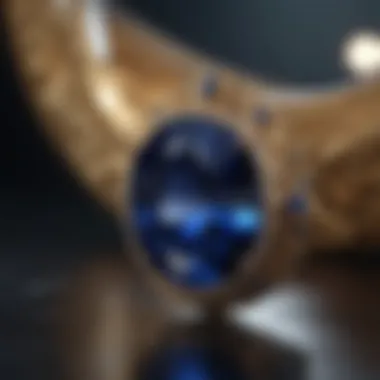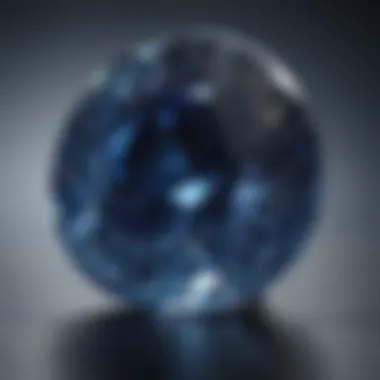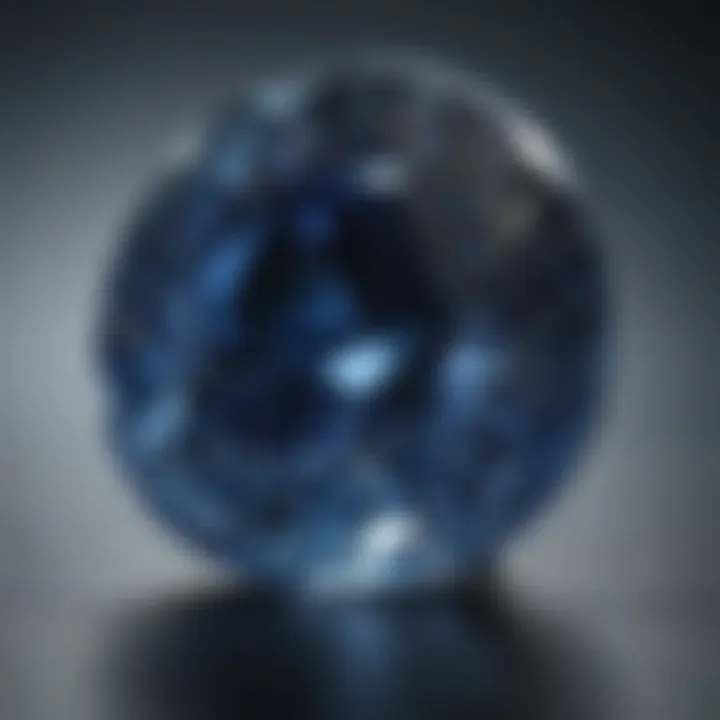Understanding the Cost of Sapphire Stones


Intro
Sapphires are among the most desired gemstones in the world. Their allure captivates gem enthusiasts, collectors, and jewelry designers alike. Understanding the factors that dictate the price of sapphires is essential for anyone looking to invest in these stunning stones. In this article, we will analyze the intricate details influencing the cost of sapphires, enabling you to make informed decisions whether for personal collection or commercial purposes.
Gemstone Overview
Definition and Origins
Sapphires belong to the corundum family, a mineral primarily composed of aluminum oxide. While this gemstone is best known for its deep blue hues, sapphires actually come in a variety of colors including pink, yellow, and green. The term ‘sapphire’ originates from the Latin word "sapphirus," and the Greek word "sappheiros," both referring generally to the blue stone, but it's important to note that sapphires of every color are sought after in today’s market.
Historically, sapphires have held a special place in jewelry. From the regal crowns of ancient kings to modern engagement rings, they symbolize power, wisdom, and nobility. Ancient Persians believed that the sky was blue because it reflected sapphires, understanding the stone's connection to divine matters and spirituality.
Historical Significance
Throughout history, sapphires have adorned the jewels of royals and religious figures. These gemstones were often associated with protection and insight. In the Middle Ages, clergy wore them to symbolize Heaven, while those of higher rank believed sapphires safeguards against envy and harm.
In contemporary times, sapphires remain symbols of commitment, particularly in engagement rings. Prince Charles famously chose a sapphire for Diana, cementing its place in modern romantic tradition. The historical layers of sapphires add to their mystique and value, making this stone not just a piece of jewelry, but a fragment of history.
Gemstone Properties
Hardness and Durability
One of the most appealing attributes of sapphires is their remarkable hardness, rated 9 on the Mohs scale. This makes sapphires almost as hard as diamonds, making them suitable for everyday wear. Their durability ensures they can withstand the test of time, which is crucial for investment pieces. Unlike many gemstones, sapphires are not as prone to scratching or damage, thereby enhancing their longevity in jewelry.
Color and Clarity
The color of a sapphire plays a pivotal role in its valuation. The most recognized hue is blue, but sapphires can present in a rainbow of colors. However, the finest sapphires are often those displaying vivid richness paired with high clarity. Color saturation can range from light to dark, and the best-quality sapphires showcase a deep, intense blue.
It's also worth noting that the presence of inclusions can affect clarity and thus pricing. In professional grading, a stone’s brilliance is considered—stones with fewer imperfections are typically more valuable.
"When buying a sapphire, always consider its origin. Sapphires from Kashmir or Myanmar can fetch much higher prices due to their historical and geological prestige."
Ultimately, understanding these elements not only enriches your knowledge but can significantly impact your purchasing decisions.
End
As we delve into the multi-layered world of sapphire pricing, we will cover the numerous factors that contribute to the overall cost of these colored gems. Awareness of their properties, origins, and historical significance will provide a solid foundation for making informed choices in your sapphire journey. Stay with us as we uncover more facets of the sapphire landscape.
Understanding Sapphire Stones
In exploring the fascinating world of sapphire stones, one cannot overlook their profound impact on both jewelry and culture. The cost associated with these delightful gems is closely intertwined with an in-depth understanding of their nature, characteristics, and significance through history. It is fundamental to grasp what makes sapphires so precious, considering aspects like quality, origin, and market demand—all of which influence the final price that enthusiasts and collectors must pay.
When diving into the nuances of different sapphire types, one can better appreciate how the intricate details set them apart. For those interested in purchasing or investing in sapphires, understanding these elements can lead to more informed decisions and eventually a satisfying purchase.
What is a Sapphire?
Sapphires are typically defined as precious gemstones that come from the corundum mineral family. The most recognizable hue of sapphires is blue, yet they can appear in an array of colors, including yellow, green, pink, and even colorless. This color variation occurs due to trace elements like iron and titanium mixing with aluminum oxide during formation.
The sheer physical properties of sapphires contribute significantly to their desirability. They are known to be exceptionally hard, scoring a remarkable 9 on the Mohs scale of mineral hardness. This makes them highly durable, suitable for everyday wear. Consequently, sapphires are utilized not just in rings and necklaces, but also in watches and other fine jewelry.
Historical Significance of Sapphires
Sapphires have a rich historical backdrop, dating back centuries. In ancient times, these stones were often believed to hold protective qualities, with links to royalty and the divine. For instance, in the Middle Ages, sapphires were thought to symbolize heaven, which led to their use in ecclesiastical jewelry.
Interestingly, the allure of sapphires didn’t stop at just their beautiful appearance. Kings and queens in various cultures prized them, using them in crowns and ornaments. The blue sapphire's association with nobility remains to this day, a common choice for engagement rings and formal jewelry pieces.
"Sapphires are often intertwined with stories of love, power, and protection, making them not merely stones but carriers of historical weight."
From ancient Persian lore to modern aristocracy, sapphires have adorned the significant moments of history, making them more than just aesthetic objects. They are embedded in tales of wealth, virtue, and prosperity—enduring symbols that persist in capturing the human imagination. Their journey through history establishes a noteworthy context for anyone interested in understanding the cost and the value of these remarkable gems.
Factors Influencing Sapphire Pricing
When it comes to sapphire stones, understanding the factors influencing their pricing is essential for anyone considering a purchase. The cost of these exquisite gemstones is shaped by a multitude of elements that range from the stone's inherent characteristics to the broader market dynamics. Recognizing these aspects can empower buyers and collectors to make informed choices in the sometimes murky waters of the gemstone market.
Quality Characteristics
Color
The color of a sapphire is often its most critical quality indicator. A vibrant blue, often referred to as royal blue, is considered the most desirable and, thus, commands higher prices. Different shades, from deep, rich blues to paler tones, cater to various preferences among enthusiasts. However, sapphires come in a spectrum of colors, including pink, yellow, and even colorless stones. This variety can either enhance or diminish value depending on market trends and customer desires. For instance, pink sapphires have gained popularity recently, leading to a spike in their pricing.


- Key Characteristic: The tone and saturation of color affect market value significantly.
- Advantages/Disadvantages: A deeper hue is often seen as more valuable, which can narrow the field for buyers seeking unique shades while potentially inflating costs drastically.
Clarity
Clarity refers to the presence of any inclusions or blemishes within a sapphire. A stone with fewer impurities or visible flaws typically fetches a higher price. Consequently, high-clarity sapphires, especially those without any eye-visible inclusions, are viewed as more aspirational. However, many buyers are willing to overlook minor imperfections if the color is outstanding or if the stone possesses historical significance.
- Key Characteristic: The absence of inclusions leads to greater transparency and overall allure of the stone.
- Advantages/Disadvantages: While clarity is vital, it may not always play the decisive role in pricing as color and origin sometimes take precedence.
Cut
The cut of a sapphire greatly affects its brilliance and overall aesthetic appeal. A well-executed cut maximizes light reflection and brings out the stone's individual characteristics. Various shapes, including oval, round, and cushion cuts, can impact how a sapphire is perceived and valued. Interestingly, the cutting process may introduce additional costs, especially for meticulously crafted stones, which in turn can reflect higher pricing in the market.
- Key Characteristic: The quality of the cut can enhance or detract from the gemstone’s natural beauty.
- Advantages/Disadvantages: While a superb cut can elevate a sapphire's worth, the complexities of the cutting process can also create inconsistencies in pricing among different retailers.
Carat Weight
Last but not least, carat weight plays a significant role in determining the price of sapphires. Larger stones, particularly those exceeding one carat, are rarer and, as a result, more expensive. However, the relationship between weight and value isn't always linear. For instance, a two-carat sapphire of mediocre clarity and color could be less valued than a one-carat stone with extraordinary features. Therefore, potential buyers should not only focus on weight but also closely examine the other characteristics that define the stone's overall market value.
- Key Characteristic: In the gemstone market, larger equals rarer.
- Advantages/Disadvantages: While heavier stones can suggest greater worth, they require close scrutiny of their quality attributes to gauge true value.
Origin of the Stone
Origin plays a pivotal role in determining a sapphire's price. Sapphires from certain locations have gained reputations over centuries for their superior quality, leading to significant price disparities. Regions such as Kashmir, Burma, Sri Lanka, and Montana each impart distinctive qualities that can greatly influence demand and market prices.
Kashmir
Kashmir sapphires, famed for their velvety, royal blue color, are considered the apex of sapphire quality. The limited supply combined with high demand has inflated prices significantly. Specimens from this region often fetch exorbitant amounts especially for stones exhibiting classic hues and clarity.
- Key Characteristic: The unique hue and quality achieve a premium in the market.
- Advantages/Disadvantages: While the cachet of Kashmir sapphires boosts their desirability, their rarity makes them inaccessible to many buyers.
Burma
Burma, particularly the Mogok region, is another significant source known for producing deep blue sapphires with a hint of red, often referred to as "pigeon's blood". This richness in color makes Burmese sapphires sought after, but irregularities in mining and political issues may affect availability and price stability.
- Key Characteristic: Known for the exquisite coloration rarely found elsewhere.
- Advantages/Disadvantages: While they are in high demand, variances in sourcing could affect both availability and pricing.
Sri Lanka
Once known as Ceylon, Sri Lanka has been producing sapphires for centuries. The stones from this region come in various colors and are regarded for their good quality and market affordability. What sets Sri Lankan sapphires apart is the range of unique hues and reasonable prices that appeal to a broader audience.
- Key Characteristic: A diverse palette that caters to differing consumer tastes.
- Advantages/Disadvantages: While affordability is a perk, the variance in quality can make it challenging for buyers to ascertain value.
Montana
Montana sapphires have recently garnered attention in the market. Although they may not command the same prices as stones from traditional regions like Kashmir or Burma, their unique pastel colors and ethical sourcing philosophies are raising interest. Notable for their clarity and environmental cultivation practices, Montana sapphires are gaining traction—particularly among conscious consumers.
- Key Characteristic: Ethical sourcing appeals to modern buyers.
- Advantages/Disadvantages: Though they are less prestigious than their counterparts, Montana sapphires offer unique value propositions appealing to gems enthusiasts.
Market Demand and Supply Dynamics
The ebb and flow of market demand directly correlate with supply dynamics. Trends can shift as new preferences emerge, unexpectedly altering prices. Moreover, global economic factors, including luxury consumption trends and even trade policies, can impact availability. In recent years, digital platforms have made it easier for consumers to access sapphires worldwide, changing conventional buying patterns.
In sum, detailed attention should be paid to the factors influencing sapphire pricing. Each element combines to create a unique landscape that can assist consumers in understanding the value, availability, and desirability of these radiant gemstones as they navigate their purchasing decisions.
Sapphire Pricing Trends
Understanding the pricing trends of sapphire stones is essential for both buyers and enthusiasts alike. This section aims to shed light on the elements that shape sapphire pricing over time. By examining historical price fluctuations and current market conditions, readers will gain insights that can inform their purchasing decisions and enhance their awareness of this captivating gemstone.
Historical Price Fluctuations
Sapphire prices have witnessed significant changes throughout history, influenced by various economic and social factors. For instance, during the late 20th century, the demand for sapphires surged as they became not just a symbol of luxury but also a popular alternative to diamonds. The rise of global markets, particularly in Asia, played a crucial role in this growth.
Additionally, renowned sources like Kashmir have historically contributed to price hikes due to their unmatched quality and rarity. As those mines neared depletion, prices for Kashmir sapphires soared, sometimes fetching tens of thousands of dollars per carat.
Key events impacting sapphire pricing include:
- Economic downturns: Recessions often lead to decreased spending on luxury items, affecting prices.
- Mining discoveries: New discoveries of sapphire deposits can either stabilize or lower prices, depending on their size and quality.
- Fashion trends: The increasing popularity of sapphire engagement rings in the early 2000s caused a dramatic uptick in demand, subsequently lifting prices.
Current Market Conditions
In the current landscape, the sapphire market faces unique conditions that influence pricing. Today, consumers are more mindful of ethical sourcing and sustainability, which has led to a notable rise in interest for untreated and responsibly mined sapphires. As a result, sapphires from regions known for ethical practices, such as Montana, are fetching higher prices due to consumer preference.


Several elements currently shaping sapphire prices include:
- Market demand: The growing awareness about the value of natural sapphires over treated options has intensified competition among buyers, pushing prices upward.
- Global trading influences: Changes in import/export regulations, currency fluctuations, and tariffs can all affect prices significantly. For example, a strengthening dollar can make gemstones sourced from overseas pricier for American buyers.
- Technological advancements: The rise of online marketplaces has democratized access to sapphires, allowing consumers more diverse purchasing options while simultaneously increasing price transparency.
"Understanding the nuances of sapphire pricing can empower consumers to make informed choices in their gemstone investments."
As sapphire stones continue to captivate collectors and jewelry enthusiasts, grasping the historical and current pricing trends can be a powerful tool in navigating this complex market.
Price Comparison: Natural vs. Treated Sapphires
When delving into the complexities of sapphire pricing, understanding the distinctions between natural and treated sapphires is paramount. Each category not only holds unique attributes but also appeals to different markets and collectors. The implications for buyers can be significant, influencing both value assessments and purchase decisions.
Natural sapphires are those that exist in their original forms, formed over millions of years within the Earth. These stones often command higher prices due to their rarity and historical significance. In contrast, treated sapphires have undergone processes to enhance their color or clarity, making them more visually appealing at a lower cost. Knowing the difference between these two options provides clarity, ultimately guiding collectors and enthusiasts in making informed choices.
Natural Sapphires
Natural sapphires are often seen as the crème de la crème of gemstones. Their value can skyrocket, particularly when they boast exceptional qualities. Here are some of the characteristic features that elevate their price:
- Rare Origin: Sapphires from famed regions like Kashmir or Burma typically fetch higher prices. These locations are known for producing some of the most stunning and sought-after sapphires.
- Unaltered Beauty: The intrinsic characteristics of natural sapphires, such as unique color saturation and inclusions, are valued by purists who appreciate the authentic, untouched nature of these gems.
- Investment Grade: Many collectors view natural sapphires as an investment. The potential for appreciation in value makes them desirable in the long run.
However, it's crucial to note that natural sapphires can vary widely in price based on quality parameters. The presence of inclusions, the stone's cut, and overall clarity play significant roles.
Treated Sapphires
Treated sapphires, while often less expensive than their natural counterparts, still offer tremendous beauty and value. The treatment processes aim to enhance color and clarity, making stones more marketable without changing their fundamental nature. Important aspects of treated sapphires include:
- Enhanced Attributes: Treatments like heat treatment or diffusion can bring out vivid colors that may not be found in untreated stones. This makes them appealing to buyers seeking beauty at a lower price point.
- Greater Accessibility: Since treated sapphires are often less expensive, they become a practical choice for many buyers who may not want or cannot afford natural stones at premium prices.
- Ethical Considerations: Many argue that treated sapphires can be more ethically sourced, as they often involve less environmental impact during extraction and production compared to natural counterparts.
Nevertheless, those considering purchase should approach treated sapphires with awareness. Understanding the nature and extent of the treatment can prevent misinterpretation of value.
"The value of a sapphire is often shaped by its original state. Knowing the difference between natural and treated is like knowing the story behind a work of art."
Evaluating Sapphire Value
When diving into the world of sapphires, understanding their value is paramount for both sellers and buyers. The assessment of a sapphire's worth goes far beyond its aesthetic appeal—it's rooted in a combination of scientific appraisal and subjective factors. Evaluating sapphire value not only informs pricing strategies for collectors and retailers, but empowers consumers to make enlightened purchases, ensuring they are investing in genuine quality.
A meticulous evaluation will encompass several elements, such as origins, treatments, and the standard four Cs: Color, Clarity, Cut, and Carat Weight. This multifaceted approach is essential for grasping what makes each stone unique and valuable.
Professional Appraisals
Professional appraisals hold a precise place in the sapphire evaluation landscape. These appraisals are conducted by certified gemologists who rely on their specialized expertise and tools. The advantage of obtaining a professional appraisal is the reassurance it provides—customers can rest easy knowing they have an expert's evaluation, shielding them from potential pitfalls in valuation.
During the appraisal process, the gemologist will meticulously investigate the sapphire's qualities. Key considerations include the stone’s color saturation, the presence of any inclusions, and how well it has been cut. As an example, a deep royal blue sapphire from Kashmir, with minimal inclusions and an excellent cut, can fetch prices that are leagues ahead of a lighter, included stone.
The appraisal also documents essential attributes of the gemstone, often producing a certificate that can enhance resale value. This documentation becomes invaluable when, say, looking to sell the sapphire or when passing it down through generations. Credibility comes into play here; a documented professional appraisal essentially bolsters the stone’s marketability.
DIY Evaluation Methods
For those who prefer to take matters into their own hands, there are several DIY methods available for sapphire evaluation. While not as accurate as professional assessments, these methods can provide a basic understanding of a sapphire's characteristics.
- Visual Inspection: Start with a keen eye. Look for even color distribution and evaluate whether there are any significant inclusions visible to the naked eye. A high-quality sapphire typically exhibits vivid, uniform color without eye-visible flaws.
- The Scratch Test: Sapphires score a 9 on the Mohs scale of mineral hardness. Using a material with a lower hardness, like glass, can help you determine whether your stone is indeed a sapphire. If the sapphire doesn't scratch, it’s likely genuine.
- Light Test: Shine a flashlight through the sapphire. If it’s a quality sapphire, the clarity should allow light to pass through beautifully, casting a soft hue rather than creating uneven spots of light.
Here's a word of caution: these DIY methods do not substitute for professional evaluation; they are simply first-pass filters that can help users identify certain features.
In summation, both professional appraisals and DIY methods provide paths to assessing sapphire value. Whether you’re a connoisseur, a collector, or just stepping into jewelry design, knowing the worth of a sapphire is crucial for making informed decisions in the vibrant realm of gemology.
Purchasing Sapphires: A Guide
Navigating the sapphire market can be quite the endeavor, especially with the gemstones' varying qualities and price points. Knowing how to buy a sapphire can significantly impact your satisfaction. This section aims to shed light on crucial factors when purchasing sapphires, emphasizing the importance of informed buying decisions.
Choosing the Right Retailer
When purchasing sapphires, the retailer plays a significant role in ensuring the quality and authenticity of your stone. Not all sellers are created equal. Therefore, it’s paramount to choose a reputable retailer to guard against potential pitfalls.
Start by doing your homework. Look for retailers who have good customer reviews and a long-standing presence in the industry. You might consider vendors like James Allen or Blue Nile, for example. Check their certifications, and see if they offer a return policy. Word of mouth can also be invaluable—often, recommendations from friends or family can lead you to trustworthy sources.
Additionally, visiting local jewelry stores can provide an opportunity to see and feel the sapphires in person. Sometimes, feeling the stone's weight and seeing its color in different lighting can make all the difference. These factors can provide clarity that photos online cannot. In the end, seek retailers who prioritize transparency about their gemstones’ origins and treatment processes. Authenticity should always be at the forefront of your buying experience.
Understanding Certificates of Authenticity
Certificates of authenticity are essential in the gemstone market. They serve as proof of the sapphire's origin and its characteristics, which can, and often do, affect its value. A quality certificate will detail the stone’s color, cut, clarity, carat weight, and any treatments it has undergone.


When examining a sapphire, you want to ensure that you receive a certificate from a reputable gemological institution. Organizations such as the Gemological Institute of America (GIA) or the American Gem Society (AGS) are among the gold standards.
"A certificate might seem like just a piece of paper, but it’s your first line of defense against scams and misrepresentation."
With CGA or AGS certification, you can rest easy knowing that your sapphire has been evaluated by experts. Many retailers will provide certificates upon purchase, but don’t hesitate to ask for it if it is absent. Understanding these certificates can also guide your purchase choice. For instance, a sapphire with a natural origin is generally worth more than one that has been treated.
In short, when you focus on choosing a right retailer and understanding certificates, you position yourself better in the sapphire market, enhancing your chances of making a wise investment.
Caring for Sapphire Stones
Caring for sapphire stones is crucial not just for maintaining their aesthetic appeal but also for preserving their value over time. Proper care ensures that these stunning gemstones continue to radiate their natural beauty, which can significantly influence their resale value. For gemstone enthusiasts and collectors, understanding the nuances of sapphire maintenance is key to enjoying and cherishing these remarkable treasures.
Cleaning and Maintenance Tips
Keeping your sapphire stones clean is a practice that should not be overlooked. Regular cleaning helps to remove dirt, oils, and residues that can accumulate and diminish the brilliance of the stone. Here are some essential cleaning tips to keep sapphires glowing:
- Use Mild Detergents: A gentle soap mixed with warm water forms a perfect solution for cleaning. Avoid harsh chemicals, which can harm the stone or its setting.
- Soft Brushes: A soft-bristled brush, like a toothbrush, makes for an ideal cleaning tool. Gently scrub around the stone and the mounting. Too much pressure can harm both the gem and the setting.
- Rinse and Dry: After cleaning, rinse the sapphire thoroughly under lukewarm water to ensure no soap residue remains. Pat it dry with a soft cloth, as rubbing can scratch the surface.
Many people might assume that their sapphires don’t need much care, but even something as simple as body oils from wearing a ring can lead to buildup. Remember, prevention is better than cure, so incorporate routine cleaning into your jewelry care regimen.
Storage Recommendations
When it comes to storing sapphires, the overarching aim is to protect them from scratches, environmental factors, and potential damage.
- Individual pouches or boxes: Each sapphire, especially if it comes in a unique shape or cut, should be stored separately. This reduces the risk of scratching against other jewelry pieces.
- Avoiding sunlight: Although sapphires are sturdy gems, long exposure to direct sunlight can fade their color over time. A dark, cool area is preferable for storage.
- Humidity control: A humid environment can cause dirt buildup. Consider using silica gel packs in storage boxes to absorb moisture.
"Storing your sapphires safely can ensure their longevity. With the right precautions, your gems can dazzle for generations to come."
Ultimately, understanding how to care for your sapphire stones not only enriches your ownership experience but also shows respect for their natural beauty and intrinsic value. Whether you're wearing them on your finger or displaying them in a collection, regular attention to their care will ensure they remain as striking as the day you acquired them.
Sapphire in Jewelry and Decoration
When it comes to gemstones, sapphires are more than just eye-catching; they represent a blend of beauty and significance that resonates throughout cultures and epochs. From royal tiaras to contemporary engagement rings, sapphires are woven into the very fabric of jewelry design. Their allure lies not just in their vibrant hues but also in the stories they tell, making them a prized choice for many.
Popular Jewelry Settings
There’s something about a sapphire that makes it pop, especially in the right setting. Let’s delve deeper into some of the most adored jewelry styles:
- Classic Solitaire: This timeless design showcases the sapphire as the main star, often complemented by a simple band. It’s about letting the gem speak for itself.
- Halo Settings: This style frames the sapphire with smaller diamonds, creating an enchanting aura that accentuates its color and sparkle.
- Three-Stone Designs: These pieces usually feature a larger sapphire flanked by two other stones, symbolizing the past, present, and future—a sentimental choice for meaningful relationships.
- Vintage-Inspired Settings: For those who appreciate the charm of yesteryear, vintage designs with intricate details and scrollwork can showcase sapphires beautifully.
Sapphire in Interior Design
Sapphires aren’t just for the adornment of people. Their deep blues have become a favorite in interior design as well. Imagine rich sapphire tones on a wall or in decorative accents, invoking a sense of tranquility and luxury. Here's how they can be effectively utilized:
- Color Schemes: Incorporating sapphire into a color palette can elevate a space. Paired with lighter shades, it creates a serene atmosphere; against golds or dark woods, it evokes opulence.
- Accent Pieces: Sapphires can be showcased in decorative items like vases, cushion covers, or art pieces, hinting at sophistication without overwhelming the decor.
- Jewelry Displays: For jewelry enthusiasts or collectors, showcasing sapphire pieces in a well-designed display can turn personal heritage into a conversation starter in any room.
"Sapphires in interior design not only add a touch of elegance but also evoke feelings of calm and stability, much like the ocean's depths."
The End
The Future of Sapphire Pricing
When contemplating the future of sapphire pricing, it’s essential to grasp just how deeply intertwined market dynamics, consumer preferences, and ethical considerations are becoming. Recent shifts in consumer behavior and an increasing demand for transparency in sourcing are shaping prices in ways that were nearly unheard of a generation ago. Sapphires, with their captivating beauty and diversity, are positioned uniquely in the luxury market, which can mean volatility but also opportunity for thoughtful investors and buyers alike.
*
Emerging Market Trends
As we peer further into the crystal ball, several trends are emerging that could very well redefine sapphire pricing. The global gemstone market is not merely driven by traditional luxury consumers. New demographics are becoming involved. Millennial and Generation Z jewelry enthusiasts are looking for more than just physical beauty; they desire stories, authenticity, and sustainability woven into their purchases.
- Digital Influence: With the rise of e-commerce platforms, sapphires are now accessible to a wider audience. People are scouting for unique stones and comparing prices online, driving costs up in some markets while decreasing them in others. It's the proverbial double-edged sword.
- Investment Value: More folks are regarding sapphires less as a decorative ornament and more as an investment. This has led to an uptick in certain types of stones, especially those with rare color variations or historical significance.
- Global Accessibility: International trade has leveled the playing field. Stones once difficult to obtain are now available on many platforms, sometimes resulting in price pressures that can either uplift or undermine established local markets.
Keeping an ear to the ground and keeping track of these trends may lead to some surprising opportunities down the line, but it requires the interest and will to dig deep.
*
Sustainability and Ethical Sourcing
The conversation around sustainability isn't just a buzzword; it's reshaping how sapphires are being sourced and sold. More buyers are prioritizing ethics in their purchasing decisions. Sapphires sourced responsibly can command higher prices—something truly remarkable in this arena.
- Ethical Mining Practices: Consumers are becoming increasingly wary of the environmental impact of mining. Vendors who can demonstrate commitment to ethical practices often find themselves with a loyal customer base willing to pay a premium.
- Traceable Supply Chains: As traceability becomes the norm, sapphires with verifiable sourcing can hold greater market value. Buyers want to know where their gems come from, and sellers are keen to provide this information as a selling point.
- Industry Standards: Various organizations are working towards setting benchmarks for sustainable gemstone practices. This may create a ripple effect, pushing the entire industry toward higher standards which, in turn, would impact pricing structures.
In summary, the road ahead for sapphire pricing is likely to be shaped by evolving consumer values around sustainability and ethical sourcing, making it essential for buyers and sellers alike to stay informed. The upcoming years may prove that buying a sapphire isn’t just a purchase; it’s a choice in supporting a more sustainable future.
"The future of sapphire pricing isn’t just about the stones themselves; it’s about the values that underpin them."
The importance of these factors cannot be overstated. By staying attuned to these shifts, anyone in the sapphire market can not only navigate pricing trends but potentially influence them as well.



